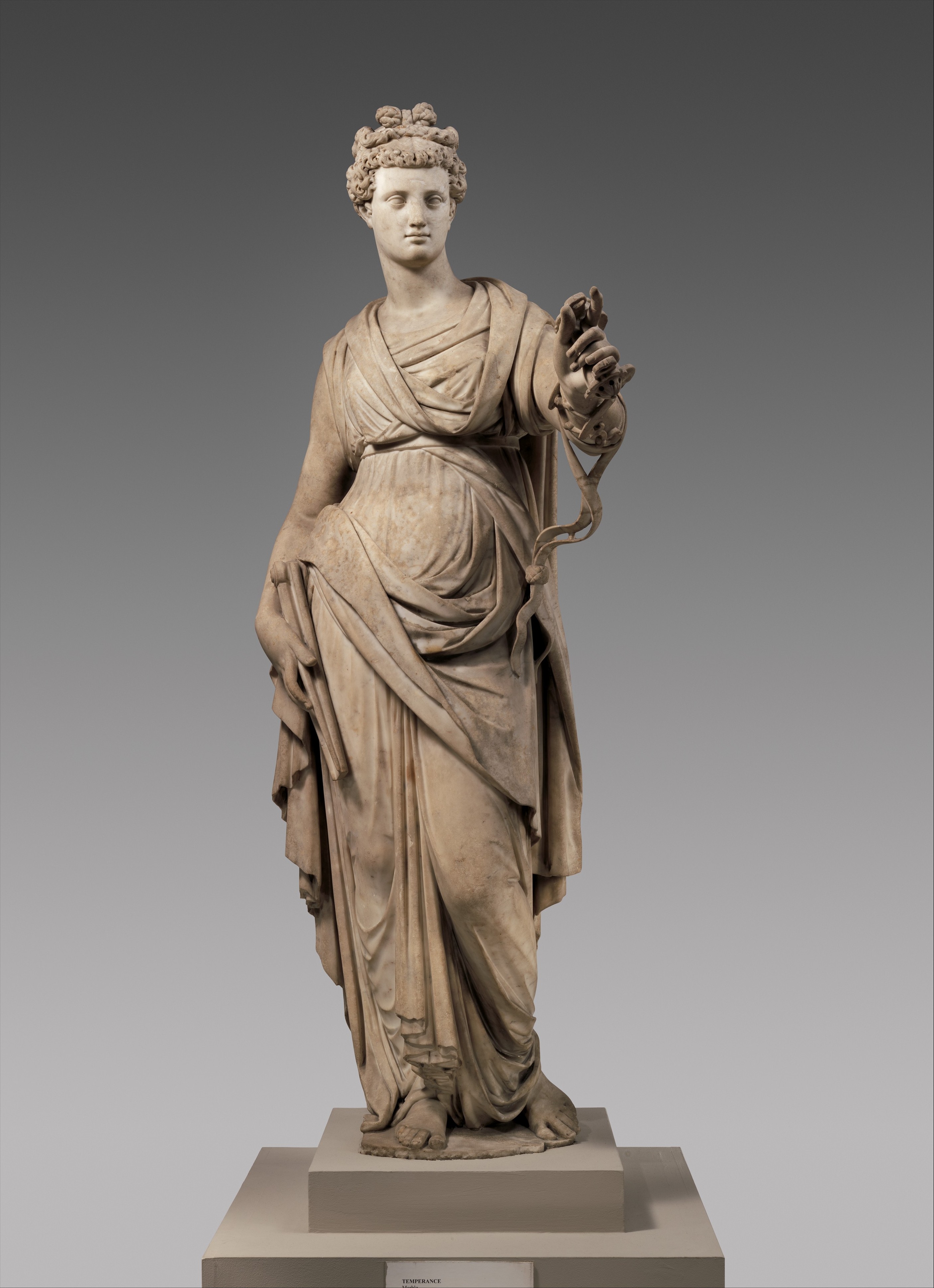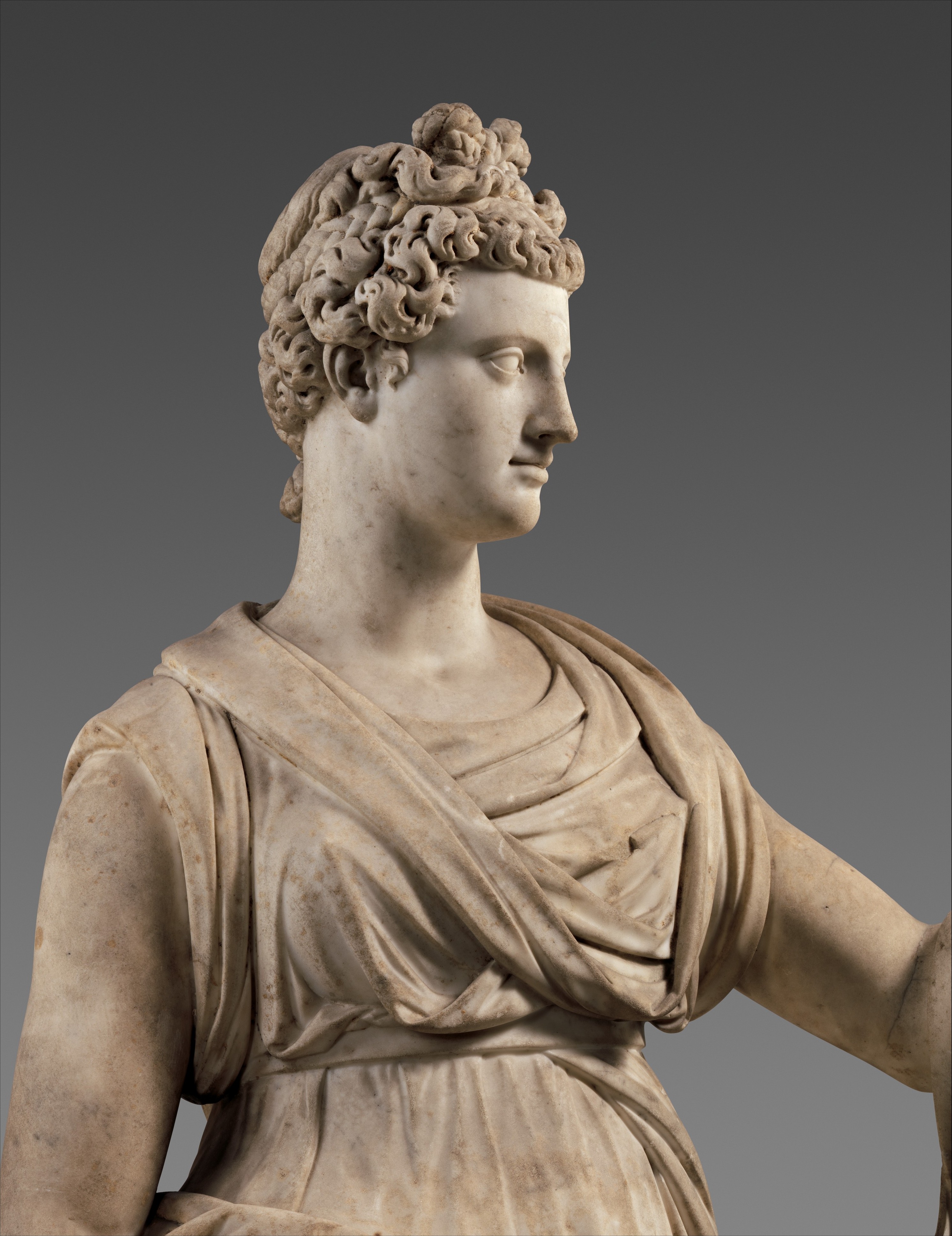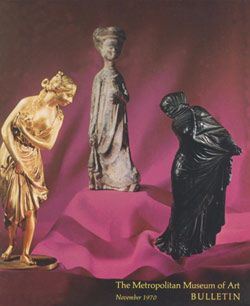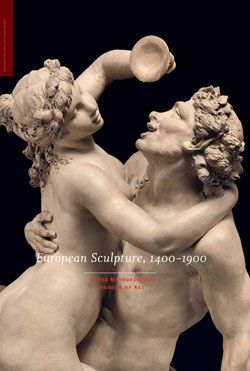Temperance
Giovanni Caccini Italian
After a model by Giambologna Netherlandish
This Temperance is identified by the items she holds: a bridle in one hand and dividers and ruler in the other. Clutching the bit with its bold bosses and its strap wrapped around her forearm like a defensive weapon, she admonishes us with pointed finger to follow her lead. The two mathematical instruments stand for the restraint of reason, which shapes a life measured by intellect, in contrast to the bridle, which signifies control over physical urges.[1] Befitting her character, Temperance is poised and contained, her body tightly wrapped in thick drapery, her hair carefully braided. Her look is stern, and her gesture suitably simple and direct.
From the seventeenth-century art historian Filippo Baldinucci, we know that the statue was placed "at the head of the alley in the small garden" of the Florentine house belonging originally to Giovanni Battista Milanesi,[2] the bishop of Marsica (called the bishop of Marsi). There it stood alone, not accompanied by statues of the three other cardinal virtues, prudence, fortitude, and justice, a group of four often seen together on tombs. It is also noteworthy that the sculpture was a central feature of a garden, a place often filled with licentious and playful statues that encourage relaxation rather than promote virtuous behavior.
The religious aspect of the virtue of temperance is underscored by the model on which this marble sculpture is closely based: Giambologna’s lifesize bronze Temperance, made for the chapel of Luca Grimaldi in the church of San Francesco in Genoa.[3] The relationship of the marble statue to the style of Giambologna was so manifest in the seventeenth century that Baldinucci ascribed it to that sculptor, only correcting himself in a footnote to say that it was actually by Giovanni Caccini. The mistake is not surprising, as Caccini was one of Giambologna’s closest followers.[4] Caccini’s career as sculptor and architect included many commissions for churches in Florence: among his greatest works were statues for the high altar of Santo Spirito (1599 – 1613), and he was one of the distinguished sculptors working under Giambologna on the great bronze doors of Pisa Cathedral (1588 – 96). Temperance is one of his early sculptures. Art historian Raffaello Borghini’s reference to it as under way in 1583 lends precision to its dating.[5] Furthermore, its solid stance and gentle forward motion reflect Caccini’s experience between 1583 and 1590 restoring classical sculptures for the Medici.
As an early work by the sculptor, it is not surprising that Temperance betrays the close attention he paid to the oeuvre of Giambologna. This is the sole statue by Caccini that is directly based on a piece by the principal sculptor of the day, and it is full of motifs from other works by that master. Since Giambologna’s bronze was placed in the Grimaldi Chapel in Genoa in 1584, Caccini must have studied the lifesize plaster model for it in Giambologna’s Florentine studio. As Olga Raggio observed, the marble borrows the bronze’s stance, its crisscross of tight triangles of drapery, and its attributes but is more sober than its source.[6] The organization of the drapery is followed nearly verbatim: bunched over the chest, sweeping across the torso to the virtue’s right hip, and falling straight down between the legs. Small changes, however, transform the character of the figure. The left foot of Caccini’s virtue rests on the ground and is not raised, so the sway of the body is not as pronounced as in the other statue. Her arm extends forward, not to the side, so there is a reduced sense of motion, and she stares ahead, rather than focusing on the upheld bridle. Thus, Caccini’s Temperance appears to address the viewer, unlike Giambologna’s. While both works clearly come from the same model, the bronze presents a more mannered figure and active surface and the marble has a quieter effect, which Caccini achieved by flattening and simplifying the pleats of drapery across the chest. By switching the attributes from one hand to the other he privileged the bridle, so the restraint of the body more than that of the intellect is emphasized, perhaps reflecting the client’s wishes. The head of the Caccini piece bears no relation to the Grimaldi bronze version with its garland and headdress, but the braids tied behind and into a bow at the top are motifs borrowed from Giambologna’s Bathing Venus, known in bronzes based on a model of about 1583,[7] and from the marble Venus of the Grotticella in the Boboli Gardens in Florence of 1572 – 73.
Temperance is also related closely to Caccini’s own marble statues of the period. It has the straight-on pose and thick falls of drapery of Saint Bartholomew (ca. 1580 – 85) in the Carnesecchi Chapel of the church of Santa Maria Maggiore, Florence. Some of the artist’s later work, such as the Angels or Saint Anne for the high altar of Santo Spirito, exhibit a dynamic movement and expressive detail that anticipate the Baroque.[8] By comparison, Temperance is conservative, merging aspects of Giambologna’s style with lessons from ancient statuary.
[Ian Wardropper. European Sculpture, 1400–1900, In the Metropolitan Museum of Art. New York, 2011, no. 29, pp. 93–95.]
Footnotes:
Note: See Provenance: Filippo Baldinucci. Notizie dei professori del disegno da Cimabue in qua. Florence, 1681-1728. Reprint ed., 7 vols. Florence, 1845-47. [Reprint ed., vols. 1-5. Florence, 1974-75.], vol. 2, p. 567.
1. In traditional iconography, dividers signify prudence; in this instance, Caccini used them to characterize temperance, along with that virtue’s usual symbol, a ruler. For the iconography of dividers in particular, see Deborah Menaker. "Lorenzo Bartolini’s Demidoff Table." Metropolitan Museum Journal 17 (1982), pp. 75–86, p. 83.
2. Baldinucci 1681 – 1782/1845 – 47, vol. 2, p. 567.
3. James Holderbaum. The Sculptor Giovanni Bologna. Outstanding Dissertations in the Fine Arts. New York, 1983 (p. 324, n. 12, and pl. xcii, fig. 182) notes that "[Giambologna’s] figure is specified as Statua Prudentia in the original contract, but as Temperentia in unpublished casting records made in Florence."
4. Elisabeth Dhanens. Jean Boulogne: Giovanni Bologna fiammingo, Douai 1529–Florence 1608. Bijdrage tot de studie van de kunstbetrekkingen tussen het Graafschap Vlaanderen en Italië. Verhandelingen (Koninklijke Vlaamse Academie voor Wetenschappen, Letteren en Schone Kunsten van België, Klasse der Schone Kunsten) 11. Brussels, 1956, p. 72.
5. Raffaello Borghini. Il Riposo. Florence, 1584, p. 647.
6. Olga Raggio was the first to note the statue’s relationship to Giambologna’s Temperance and point to the elements in it of Caccini’s own style; Olga Raggio. "The Metropolitan Marbles." Art News 67, no. 4 (Summer 1968), pp. 45–49, 72–73, pp. 45, 47.
7. For example, Bathing Venus (Metropolitan Museum, acc. no. 24.212.16).
8. Maria Ida Catalano. "Scultori toscani a Napoli alla fine del Cinquecento: Considerazioni e problem." Storia dell’arte, no. 54 (May–August 1985), pp. 123–32, fig. 13 (Saint Anne).
Due to rights restrictions, this image cannot be enlarged, viewed at full screen, or downloaded.
This artwork is meant to be viewed from right to left. Scroll left to view more.






